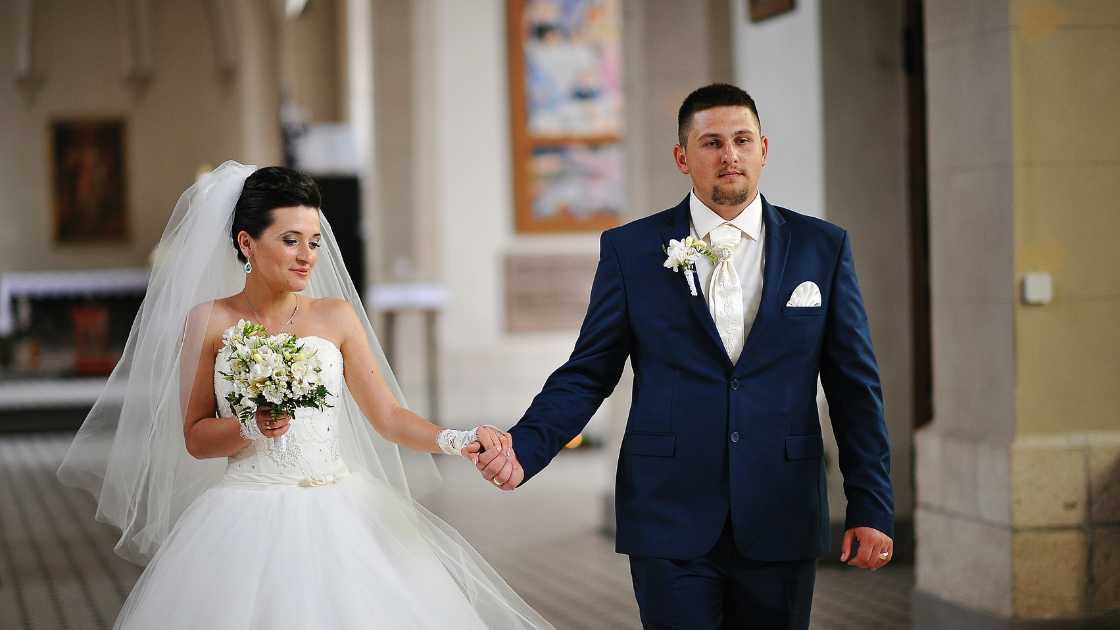How Long is a Catholic Wedding? Unraveling the Sacred Union with Timeless Traditions

A Catholic wedding is more than just a ceremony; it is a sacred union blessed by God, rooted in rich traditions and profound symbolism. As couples embark on this beautiful journey of love and commitment, they often wonder how long this holy celebration lasts. Let’s delve into the intricate details of a Catholic wedding, from the preparation to the final blessing, and understand the significance of each moment.
There are 9 Easy Steps For a Catholic Wedding
Preparation and Pre-ceremony Rituals:
Before the actual wedding day, the couple engages in thoughtful preparation to embrace the sacrament of marriage fully. This involves attending pre-marriage classes, meeting with the priest, and completing necessary paperwork. These preparations help the couple comprehend the significance of their commitment, not just to each other but also to their faith.
The Joyful Gathering:
On the day of the wedding, family, friends, and fellow parishioners come together to witness and celebrate the couple’s love. The congregation’s gathering not only shows support for the soon-to-be-wedded couple but also represents the wider Catholic community’s blessings.
The Entrance and Procession:
As the anticipation builds, the wedding ceremony begins with the entrance of the bride and groom. Accompanied by the bridal party, the couple walks down the aisle, symbolizing their individual journeys merging into one shared path.
The Nuptial Mass:
In most Catholic weddings, the ceremony includes a full Mass, making it distinct from weddings in other traditions. The Mass is a significant part of the celebration, as it centers the union of the teachings of Christ, emphasizing love, sacrifice, and unity.
The Liturgy of the Word:
During the Nuptial Mass, specific scriptural readings are chosen to reflect upon the sacred bond of marriage. These readings convey messages of love, fidelity, and commitment, guiding the couple on their path to a blessed life together.
The Exchange of Vows and Rings:
The pivotal moment arrives when the couple exchanges their vows and rings. The vows are promises made to each other, reflecting their commitment to stand by one another through thick and thin. The rings, symbolising eternal love and fidelity, are blessed by the priest before they are exchanged.
The Nuptial Blessing:
Following the exchange of vows and rings, the couple receives the Nuptial Blessing from the priest. This blessing imparts God’s grace upon the couple, empowering them to fulfill their roles as loving partners, devoted parents, and faithful members of the community.
The Unity Candle or Other Rituals:
Some Catholic weddings may include additional rituals, such as the lighting of a unity candle, symbolizing the merging of the couple’s lives and families. These rituals add personal touches to the ceremony while honoring the tradition’s core values.
The Final Blessing and Recessional:
As the ceremony draws to a close, the priest imparts the final blessing on the newlyweds, seeking God’s guidance and protection for their future. The couple then joyfully exits the church, accompanied by their loved ones, ready to embark on their shared journey as a married couple.
FAQs
How long does a typical Catholic wedding ceremony last?
A typical Catholic wedding ceremony, including the Nuptial Mass, usually lasts around one hour to one and a half hours. The exact duration may vary depending on certain factors, such as the number of scripture readings, the inclusion of additional rituals (e.g., unity candle lighting), and the couple’s preferences for music and hymns. The celebrant may also play a role in determining the ceremony’s length, as some priests may have more elaborate or concise ways of conducting the service.
Are there any specific elements that contribute to the duration of a Catholic wedding?
Yes, several elements contribute to the duration of a Catholic wedding:
Nuptial Mass:
If the couple chooses to have a Nuptial Mass as part of their wedding ceremony, it will naturally extend the overall duration. The Mass involves liturgical prayers, scripture readings, and the Eucharistic celebration.
Number of Readings:
The couple typically selects readings from the Bible to be included in the ceremony. The more readings they choose, the longer the ceremony will be.
Rituals and Traditions:
Certain rituals and traditions, like the exchange of vows and rings, may add time to the ceremony. Other optional rituals, such as the lighting of a unity candle, can also contribute to the overall duration.
Personalization:
If the couple chooses to include personal touches, like personal vows or special music performances, it can add extra time to the ceremony.
Can a Catholic wedding ceremony be shorter in duration if desired?
Yes, a Catholic wedding ceremony can be made shorter if the couple prefers a more concise celebration. Couples can discuss their preferences with the officiating priest to tailor the ceremony to their liking while still adhering to the essential elements of a Catholic wedding. Shortening the ceremony might involve selecting fewer scripture readings, skipping certain rituals or hymns, and keeping the homily (sermon) brief.
Conclusion
A Catholic wedding is not confined to a specific duration, but rather, it unfolds through various stages, each carrying deep significance. From the preparation and pre-ceremony rituals to the Nuptial Mass, vows, and blessings, every moment in a Catholic wedding is a reflection of the profound love shared between the couple and their commitment to God. As the ceremony concludes, the couple steps forward into their new life together, rooted in faith, hope, and love, knowing that their bond is strengthened by timeless traditions and the blessings of their community.




